Seven month annual....
-
Members Online
- hypertech
- kortopates
- AspiringOwner
- jamesyql
- Justin Schmidt
- BrentS
- mmcdaniel33
- pkellercfii
- GeeBee
- BillyT0020
- N201MKTurbo
- Yugow
- shawnd
- Jeff Uphoff
- 0TreeLemur
- hubcap
- 201Steve
- Brian E.
- KZNY
- Jay67F
- Skates97
- 1980Mooney
- Schllc
- Gilt
- 201Mooniac
- M20F
- Marc_B
- Jason 1996 MSE
- jeremyc209
- GoDemonDeacons
- Peter T
- MDMooney
- Beechbum
- Brian2034
- Culver LFA
- Mooney in Oz


Recommended Posts
Join the conversation
You can post now and register later. If you have an account, sign in now to post with your account.